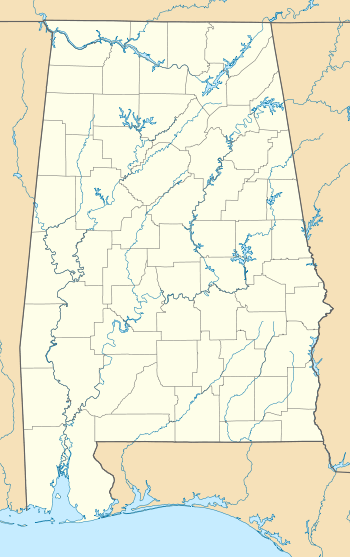Belvoir (Saffold Plantation)
| Belvoir | |
|---|---|
|
Belvoir in March 2011 | |
| Location | Pleasant Hill, Alabama |
| Coordinates | 32°12′10″N 86°57′43″W / 32.20278°N 86.96184°WCoordinates: 32°12′10″N 86°57′43″W / 32.20278°N 86.96184°W |
| Founded | 1825 |
| Built | 1845-55 |
| Architectural style(s) | Greek Revival |
| Governing body | Private |
| Official name: Belvoir (Saffold Plantation) | |
| Designated | November 2, 1990[1] |
 Location of Belvoir in Alabama | |
Belvoir, also known as the Saffold Plantation, is a historic plantation and plantation house near Pleasant Hill, Alabama, United States. The Greek Revival-style house features a Carolina-type, hexastyle portico with Doric columns. It was added to the Alabama Register of Landmarks and Heritage on November 2, 1990.[1]
History
Belvoir was established as a coton plantaion in 1825 by Reuben Saffold II. Saffold was born on September 4, 1788 in Wilkes County, Georgia. He was educated there and began a law practice in Watkinsville, Georgia. He married Mary Evelyn Phillips, of Morgan County, in 1811. The couple would eventually have 12 children together. They relocated to Clarke County, Mississippi Territory in 1813, where he participated in the Creek War in 1813-14. Saffold served in the legislature of the Alabama Territory in 1818. He participated in the Constitutional Convention and became an Alabama circuit judge in 1819. He established his plantation, which he named Belvoir, in rural Dallas County, Alabama in 1825. Belvoir translates roughly from French to English as "beautiful to see." He remained a circuit judge until 1832, when he was appointed to the Alabama Supreme Court.[2] He served as Chief Justice from 1834 until 1836.[3]
Although the plantation at Belvoir was established in 1825, the construction date for the current main house is unclear. It is known that the Saffolds were still living in a large hewn log house in 1838, when English naturalist, Philip Henry Gosse, was serving as a teacher for the Saffolds and other area children. Some of his experiences at Belvoir, including his negative impressions of slavery, were later published in his book, Letters from Alabama: Chiefly Relating to Natural History.[4] Family records indicate that the current main house was built prior to the death of Saffold on February 15, 1847.[3] Architectural historians usually date it to the early to mid-1850s, due to stylistic elements found in its architecture.[5]

Belvoir changed hands several times following the American Civil War, with cotton production giving way to cattle farming by the mid-20th century. The Mason family from Birmingham used it and the surrounding 500 acres (200 ha) as a hunting lodge until it was bought by the McQueen family, relatives of the Masons, for $50,000 during the 1960s. The house was in a state of disrepair by the late 1990s, when it was added as a "Place in Peril" by the Alabama Historical Commission.[6] The McQueens declined several purchase offers from people that they felt weren't particularly interested in restoring the house, until meeting the Collias family from Boston. Following their purchase of the house, the Colliases restored the house to a good state of preservation.[3]
References
- 1 2 "Properties on the Alabama Register of Landmarks & Heritage". Alabama Historical Commission. www.preserveala.org. Archived from the original on 4 September 2012. Retrieved 25 October 2012.
- ↑ "Alabama's Supreme Court Chief Justices: Reuben Saffold". Alabama Judicial System. Alabama Department of Archives and History. 7 May 2010. Archived from the original on 4 December 2010. Retrieved 28 November 2010.
- 1 2 3 Hale, Jennifer (2009). Historic Plantations of Alabama's Black Belt. Charleston, SC: History Press. pp. 15–25. ISBN 978-1-59629-669-5.
- ↑ Gosse, Philip Henry (1859). Letters from Alabama: Chiefly Relating to Natural History. London: Morgan and Chase. ISBN 0-8173-0683-8.
- ↑ Cooper, Chip; Knopke, Harry; Gamble, Robert (1993). Silent in the Land. Tuscaloosa, Ala.: CKM Press. pp. 104–105, 177. ISBN 978-0-9636713-0-1.
- ↑ "Wins". Alabama's Preservation Scorecard. Alabama Historical Commission, Alabama Preservation Alliance, University of West Alabama. Retrieved 28 November 2010.
.jpg)